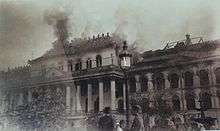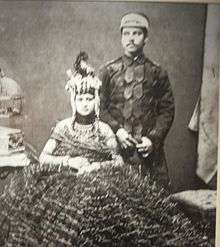Seto Durbar
Seto Durbar (White Palace) was a Rana palace in Kathmandu, the capital of Nepal. The palace complex, located south of the Narayanhity Palace, was incorporated in an impressive and vast array of courtyards, furnishings and guest halls. Seto Durbar was built by Bir Shumsher JBR in 1893 CE.[1]
| Seto Durbar | |
|---|---|
 | |

| |
| General information | |
| Architectural style | Fusion of Neoclassical architecture, Mughal,European styles of architecture |
| Town or city | Kathmandu |
| Country | Nepal |
| Construction started | 1893 |
| Demolished | 1934 |
| Cost | Unknown |
| Client | Bir Shumsher JBR |
| Technical details | |
| Structural system | Brick and Mortar |
| Size | 375 ropanis |
| Design and construction | |
| Architect | Jogbir Sthapit |


History

Seto Durbar was built by Bir Shumsher JBR in 1893 CE in a land area of 375 ropani with Lal Durbar to its northeast as his private residence.[2] In 1901 Gehendra Shamsher JBR, Bir Shumsher JBR's eldest son inherited this palace. In 1905 upon Gahendra's death his son Lila Shumsher inherited Seto Durbar.[1]
Grand State Hall
Seto durbar was famous for its Grand State Hall known as Thulo Baithak or Big hall[3]. This Grand State Hall was famous for its Belgian wall mirrors; glass lamps from Murano and Bohemian chandeliers adorned the interiors while Italian marble tiled the floors.[4][5]
Destruction of the Seto Durbar
In 1934 a massive fire broke out at Seto Durbar engulfing the palace building. Historian Purushottam Shamsher says in his book that Lila Shumsher begged the then Prime Minister Juddha Shumsher to use artillery cannon to cut off the burning wing from the non-affected wing. Juddha Shumsher declined his begging saying artillery might damage Narayanhiti Palace, the Royal residence of the King.[1] Today, the only remains of Seto durbar is a building occupied by NIDC Development Bank Head Office in Durbar Marg.[5]
Legacy
Seto Durbar is considered by historians as one of the most beautiful and extravagant palace building in the history of Nepal.[1] Today most of the Hotel Annapurna stands on the grounds of Seto Durbar[4]
References
- JBR, PurushottamShamsher (2007). Ranakalin Pramukh Atihasik Darbarharu [Chief Historical Palaces of the Rana Era] (in Nepali). Vidarthi Pustak Bhandar. ISBN 978-9994611027.
- "THE HISTORIC DURBARS OF KATHMANDU". 19 October 2014. Retrieved 5 June 2015.
- Mahat, Ram Sharan (2005). In Defence of Democracy: Dynamics and Fault Lines of Nepal's Political Economy. Adroit Publishers. p. 33. ISBN 978-81-87392-67-5.
- http://historylessonsnepal.blogspot.com/2013/04/a-time-to-build-maharajah-birs-legacy.html
- JBR, PurushottamShamsher (1990). Shree Teen Haruko Tathya Britanta (in Nepali). Bhotahity, Kathmandu: Vidarthi Pustak Bhandar. ISBN 99933-39-91-1.